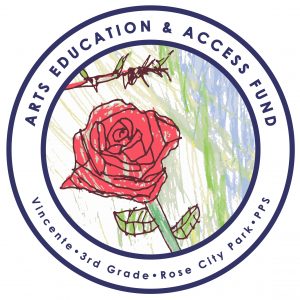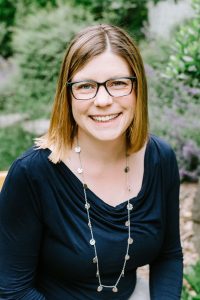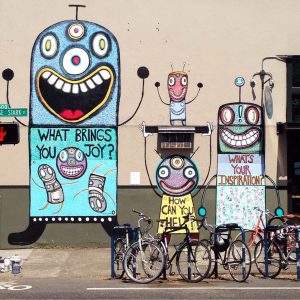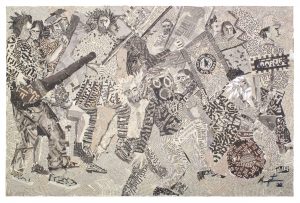Welcome to the first edition of our new K-12 Arts Educators newsletter, #newsforyourheart. As we work to reconnect and engage with this brave new world, we know it will take time, it will be painful, it will be hard, but we will also find joy, hope, and love. I hope that this newsletter will illuminate some of the work we are doing at RACC, direct you to opportunities, professional development and resources. You’ll find features about our district arts educators and arts partners. With your help we can showcase student work from our six districts. Spread some joy! Please share #newsforyourheart with your colleagues and students!
– Chanda Evans (she/her), Arts Education Program Specialist
Features & Highlights
Arts Education and Access Fund New Logo

Vincente, Rose Waterfall, logo design 2021
During the Spring of 2021, RACC and the Arts Education and Access Fund (AEAF) Oversight Committee unveiled our new student re-designed AEAF Logo. We encourage you to help guide the process of having your school proudly display this on their websites. As we work to reframe the narrative around arts funding in schools, we know that this is a small step in letting our neighbors, family, and friends know their yearly $35 payment is worth it. It goes to arts education! We thank you. To learn more about how funds from the Arts Education and Access Fund are used to support students and increase access to arts and culture in our community, click here.
All of the AEAF Oversight Committee meetings are open to the public. For more information click here.
________
Two Questions for AEAF Oversight Committee Chair, Laura Streib (she/her).
What is your favorite memory around the arts? My favorite elementary arts memory is in my 3rd-grade class. Our teacher had us do a project where we dipped yarn into various palettes of tempera paint, and then we curled them onto a large piece of black construction paper and then fling/pull it back to create these amazing abstract painted flowers. Now, my adult self is blown away that she had a class of 30 nine-year-olds flinging yarn with paint on it around her classroom! But it was very memorable and fun!

Laura Streib
What made you choose the arts as a career? Growing up within a public school system that was so supportive of the arts and music helped guide me into a career in the arts. By the time I was in high school, half of my school day was filled with arts-focused classes from symphonic band and concert choir to photography. This is why I was motivated daily to go to school, where I developed community, connected, and built life-long friendships. I founded an arts education nonprofit in Portland to help support educators and ensure that kids have an opportunity and access to build a community and have a creative space to flourish. Until our Portland Metro schools have that opportunity for kids to have continuous K-12 arts pathways – that is where I will continue to pour my efforts. Kids deserve to have a robust arts education as part of their K-12 educational experience.
Laura is at aeafpdx@gmail.com
________
Since 2010, RACC has had a unique partnership and relationship with the Kennedy Center, which brings several programs into the fold of Arts Education: Any Given Child and the Partnership for Education. In 2018 RACC was one of nine sites across the United States selected to participate in a 3-year pilot program to launch artlook®. Through this relationship with the Kennedy Center and Chicago-based developer Ingenuity, artlook® provides communities with an arts-based interactive mapping database platform. This allows school districts to understand their local arts and culture landscape and create more equitable and accessible arts and culture education opportunities for all students. School districts, educators, families, and the community can navigate arts and culture education opportunities in their region. One of RACC’s goals in arts education is to expand to other school districts and create robust arts and cultural partnerships across Oregon as they join the artlook® platform.
________
A comprehensive curated resource list from RACC’s Arts Education Program is available for download. Click here
Back-to-school resources on social emotional learning and trauma can be found here. This information is from Trauma Informed Oregon.

Orquidia Violeta, Árbol de la Vida, 2020
Professional Development: Trauma Informed Care Workshop Series
In partnership with Trauma Informed Oregon, RACC presents a series of workshops for arts educators. Please join us for our second workshop October 8. This free event will be held remotely, as we continue to center health and safety for all. Look for our Eventbrite invitation in your inbox coming soon.
The Beat: Interviews from the Field
Jessica Juday (she/her), Music Educator from West Powellhurst Elementary School, David Douglas School District
What inspires you when you teach arts education to your students?
I believe that children are inherently joyful. When I see them have fun, I am always inspired to find new ways to teach. They love experiencing new things and they are so easily swayed by excitement. Teaching music at the elementary level is so much more than reading rhythm and singing songs…. It’s about creating a love of music and sharing joy with those around you. Every day I get to watch children discover new things, and they do it with such thought and care… it’s hard to not be inspired!

Jessica Juday
What have you learned from your students?
I have learned that there is something out there for everyone! Some students may never truly love singing, but they excel at the recorder. Other students who struggle at playing the marimba end up being incredible at rhythm dictations. I even have students who say music isn’t their thing…but they are SO excited to help design the set for our musicals. Working with students from all over the world has taught me that music is just ONE beautiful part of what makes us human! I teach music to teach the whole child, not just the musical parts!
What brings you joy when you teach?
The children! Being able to watch a student go from struggling to understanding is an incredible thing. I love watching a student develop their skills from just reading rhythm all the way to composing their own song. Every tough part of my job is worth it when I see how proud students are of themselves when they learn a new skill or get better at an old skill. They are always so excited! One of my favorite times during the year is showing Kindergartners the moment in “The Wizard of Oz” when Dorothy opens the door, and the film goes from black and white to color… They gasp with wonder, and it never fails to bring a smile to my face.
________
Mrs. Langston (she/her), Music Educator from Prescott Elementary School, Parkrose School District
What inspires you when you teach arts education to your students?
Inspiration comes from many sources. The students themselves are the most inspiring part of teaching music in schools. Their enthusiasm, engagement, and inquiry for all things musical lifts and carries me through the years. Other inspiration comes from the music I teach…is it of the highest quality? Does it nurture the musical mind? Does it connect us and help us better understand ourselves and the world we live in? Does it endure? High-quality professional development is another source of inspiration. I relish the times when World Music Drumming and Hot Marimba are in town! I also keep an ear to the airwaves and find inspiration in current music-making by all types of artists. Knowing who I teach is yet another way I find inspiration. Who are these people? What are their backgrounds (culture, class, race)? What impedes their access to education? What supports them? What do they want to learn? Ideally, I use all this information to develop tuneful, beautiful, artful humans.
What have you learned from your students?

Mrs. Langston
Flexibility. Let me state that again…FLEXIBILITY. Gone are the days of a meticulously planned lesson with no time or space for anyone or anything that was not anticipated in advance. Don’t get me wrong, I still plan! I plan and prep and practice and plan some more. Then, children enter the room and things shift – really shift. What I have learned is to grab onto those shifts and use them to accomplish the same goal. Let the kids drive! My role is to facilitate and guide; going deeper is better than going wider. What’s the rush? Let’s explore together!
What brings you joy when you teach?
Time with students is most joyful for me. When I watch and listen to students who are genuinely struggling to master a skill or concept and then…they get it. I love seeing/hearing others as they break through and gain a level. When there is a room full of 8-year-olds playing drums, and marimbas and we’ve been working on sticking the ending and then…we achieve a perfect cutoff. I love seeing the effect of community and non-verbal communication on young musicians. When we’ve slogged through a particularly difficult piece of music for far too long and then…a child asks “why are we working so hard?” I love helping develop critical thinking in children. When we are invited to perform on our high school stage and these adorably small people are freaking out because they are now “big time” and then…they sing and play so well they get a true standing ovation. I love helping children achieve performance success. Every day I get to work with children, I am filled with joy!

Gary Hirsch, Questions for Humans, 2015
We would love for you to share your thoughts with this question.

Hampton Rodriguez, Protests in Portland, 2020
Call for student work to be featured in our Winter edition. Student work will be chosen randomly by district submission.
Please submit student artwork to cevans@racc.org by Dec. 1 for consideration.
More Interviews from the Field
The Independent Publishing Resource Center (IPRC) The mission of the Independent Publishing Resource Center (IPRC) is to provide affordable access to space, tools, and resources for creating independently published media and artwork, and to build community and identity through the creation of written and visual art.
An interview with Alley Pezanoski-Browne (she/they), Executive Director of IPRC.
When youth participate at IPRC, what do you want them to take away from their experiences?

Photo courtesy of IPRC
We want youth to know the history of printmaking and zines as tools for sharing community stories and highlighting historically excluded voices. We also want them to learn that art making & writing are about experimentation, problem-solving, creative thinking, and collaboration. Most of all, we take them seriously as artists, so we give them opportunities to teach what they’ve learned from others (most often their peers or their parents) as well as make art with their instructors and fellow students. We teach them the tools, but we want them to bring their own ideas and originality to making art that will mean something special to each of them. We hope that they will develop a life-long interest in art making and for experiential learning.
How can schools help encourage students to include media in the arts?
I think that a really unique part of printmaking is that, because it’s meant for easy reproduction, it’s meant to be shared. I think that school can help students to include media in the arts by really emphasizing the social communications element. It is very common in IPRC classes for youth to trade prints and zines. It helps students to be less perfection-minded and to recognize the value in their voices. They also think about how they communicate their thoughts to the world when they know it is made to be shared.
When you think of art, what inspires you?
I get really inspired by people who make art together in order to change the world they are living in, which is why I admire projects like the Living School of Art, KSMOCA or SHED.PDX.
________
Public Art & Arts Education: Featured Artist, Laura Camila Medina
By Morgan Ritter (she/her), RACC Public Art Exhibitions & Collections Coordinator

Laura Camila Medina, Consuming a Past Self, 2020
What comes to mind when you think of “Public Art”? Maybe a stoic, bronze monument of George Washington or another political figure we may have learned about in U.S. History classes, or a sanctioned street mural. Maybe Public Art for you is a mere landmark that tells you what street to turn on to find your way. Public Art can be so much more than these common perceptions–it can build worlds. It can gesture towards untold histories, bridge communities, and remind individuals of all ages that our imaginations enhance our quality of life.
At RACC, the Public Art Team avidly works to directly support a wide range of artists in the region, including both established and emerging artists. This includes artists who have wildly different approaches to what art can be including artists working in traditional, craft-based practices, or fine art, as well as artists who work experimentally at the nexus of multiple genres.
As the Public Art Exhibitions & Collections Coordinator, a crucial part of my job is engaging directly with local artists and helping RACC to imagine new opportunities for their radical creativity to be supported. One of the new initiatives I manage is Support Beam. Support Beam’s intent is to strengthen artists’ long-term creative practices and overall livelihood, by giving them money to continue making their work, without a fixed expectation of art production or media restrictions. At the end of their work periods, one piece of art is acquired from these artists into the collection. This initiative prioritizes Black, Indigenous, artists of color and emerging artists. Artists were funded between $3-$5,000 each.

Laura Camila Medina, Consuming a Past Self, 2020
Laura Camila Medina is one of the phenomenal, emerging artists that we recently funded through Support Beam. Laura’s practice is based around memory and identity as a response to personal, cultural, and historical research. Her work utilizes a unique combination of traditional mediums within digitally constructed spaces to create immersive visual analogies of cultural hybridity. Medina engages in a practice of self-reflection as a means to create a personal mythology. This mythology brings her closer to building her own world, both real and imaginary, where her identity becomes whole.
“Consuming a Past Self” is the piece she made through the Support Beam initiative, and is now part of the Public Art Collection. It is a hybrid video that combines painted collage, stop-motion animation, and performance.
The following writing is included alongside her video:
Consuming my past self is
Accepting my past self
It is processing my past self
It is digesting my past self
In order to nourish my
Future self
Laura explained that when she eats arepas (a food made from ground maize dough, originating from pre-Columbian South America), she has a memory of sitting in her grandmother’s dining room, looking at the reproduction of a painting that had drastically different colors than it did when it was new, with faded pinks. She remembers the flavor of the arepas combined with her grandmother’s milky coffee while looking at this faded painting. In this memory now, she contemplates the truth that everything ages, and aspires to recreate that taste memory.
Click here to view Laura’s video alongside other artists who participated in Support Beam.
Learn more about the other Support Beam artists on Instagram through the virtual posts #raccsupportbeam
Laura Camila Medina (b. 1995) is an interdisciplinary artist born in Bogotá, Colombia. Her immersive installations and animated collage work have been exhibited at the Center for Contemporary Art & Culture, PLANETA New York, Fuller Rosen Gallery, Wieden+Kennedy, the Portland Art Museum, and with the Nat Turner Project. She was at Open Signal, Artist in Residence at the Living School of Art, IPRC Artists & Writers in Residence Program, ACRE Residency, and most recently the Centrum Emerging Artist Residency. She earned her BFA at the Pacific Northwest College of Art and is currently based in Portland, OR. Learn more about Laura’s work here: https://lauracamilamedina.com/
For a database of public art in the Portland region, click here.
Workshops • Events • Lectures*
Sign-up for alerts about lectures, workshops, events, and conferences from local colleges and universities. Here are a few highlights:

Patricia Vázquez Gómez, Untitled 1, 2020
Latinx Heritage Month September/October, celebrating the histories, cultures and contributions of American citizens whose ancestors came from Spain, Mexico, the Caribbean and Central and South America. Teachers guide for Latinx Heritage Month (free).
Portland Latin American Festival, opening at the Hollywood Theatre in person on the big silver screen. September 22, 2021 at 7:30 p.m.
Oregon Humanities is offering an online fall course of Humanity in Perspective (HIP), a free college-credit class and learning community for students 18 years or older in Oregon who face barriers to continuing their education. Learn more and apply.
Portland Metro Stem Partnership: Join a new Elementary STEAM Leaders cohort. 15 spots for teachers for the NEW 2021-2022 Cohort. All partner districts elligible to apply, including: Banks School District, Beaverton School District, Forest Grove School District, Hillsboro School District and Portland Public Schools. Click here for more information.
Portland Open Studios October 9-17 (free).
Portland Pumpkin Patches, Corn Mazes and Hayrides, for local fall family-friendly activities and events.
Portland Film Festival Oct. 6-Nov. 8 (various venues).
Save the Dates!
The Kennedy Center National Partnerships Convening Feb. 7-8, 2022
Any Given Child Feb. 8-9, 2022 Partners in Education Annual Meeting – VIRTUAL
If you know of an event, workshop, lecture, or art exhibition that is coming up please go here to submit an opportunity.
*Please note: Some workshops/events/lectures might have changed due to COVID-19. Please check before you make plans.
The Scoop – Grow your Brain
We are often curious of what research is happening behind the scene in the space of arts education. Take a look!
| Art for Life’s Sake: The Case for Arts Education | 2021 report from the American Academy of Arts & Sciences |
 |
Americans for the Arts – COVID-19 July 2021 |
 |
edjustice – Click here for valuable resources |
Thanks to all of our partners, supporters, and funders supporting arts education.

